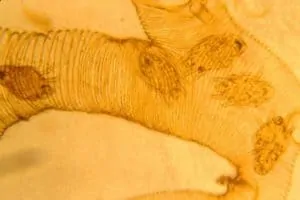The world of nature can be downright gruesome. Imagine a creature that crawls into the incredibly tiny breathing tubes of an adult bee, restricting the flow of oxygen. Then imagine it biting into the trachea of the bee and sucking its blood (hemolymph).
We have just described the tracheal mite.
Mites in a large, complex society like a bee colony are unavoidable. Many of them have no or minimal impact – they just co-exist with the bees and are either cleaned up as a matter of colony hygiene or simply have limited impact. Many have arrived after enjoying a journey with foraging bees from flowers.
But the tracheal mite is more of a problem, as would be anything that sticks in the throat and sucks blood! Let’s look at the impact of tracheal mites, how to detect them, and how to treat for them.
The following image shows numerous tracheal mites in the breathing tubes of a bee.

Definition
The tracheal mite is an internal parasite, Acarapis wood, of honey bees. They are tiny – around 0.007 inches – and can only be seen under a microscope. Female mites live in the breathing tubes of adult bees and will lay 5-7 eggs. These will mature from larvae in about 2 weeks.
The mites affect bees in numerous ways when they bite through the breathing tube to suck hemolymph. The flow of oxygen is reduced and the wound inflicted makes the bee more vulnerable to secondary infections.
Only the female mite will transfer between bees and these movements will generally occur at night. The mites cannot survive for more than a few hours outside of a host bee. The mated female mite will exit the bee’s breathing tube and attach herself to the end of a body hair. When a young adult bee passes by it will transfer to that bee and enter its breathing tube.
And so, the cycle continues…
Tracheal mite infections tend to be more expansive in cooler weather. This is because bees will cluster closer together, to stay warm, which allows the female mite to transfer between bees more easily.
Detection
The size of the tracheal mites means it is impossible to detect them visibly. Further, they spend most of their lives inside bees, aside from brief migratory periods. While the mites can be detected microscopically, their effects on the bee are the usual way for their presence to be determined. Symptoms include:
- Large numbers of bees crawling at the entrance of the hive, unable to fly
- Disorientated bees
- Bees holding their wings at unusual angles (called “K wing”)
These signs are not always visible. In extreme cases, the population of the colony can drop dramatically.
Prevention
Various approaches can be used to reduce the chance of a tracheal mite infection. Colonies with young, productive queens seem more able to deal with infestations, so requeening is often considered helpful. Certain races of bees, such as Buckfast, are also more resistant, probably due to better grooming behavior on the part of these races.
An interesting approach used by many beekeepers is “oil extender patties”. Female tracheal mites move between bees by clinging to their hairs. The patties might be made of 1 part vegetable oil and 3 parts sugar. As the bees eat they become coated in oil, which makes it more difficult for the tracheal mites to transfer between bees. The patties are often used in early spring and fall and produce good results.
Treatment
Various chemical options are available for the treatment of tracheal mites. Formic acid is effective but is extremely caustic, difficult to administer, and is not approved for use in all states. An alternative is the Thymol-based product Apigiard.
